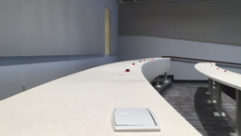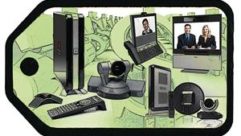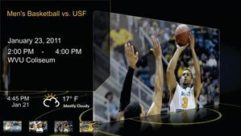
A Look at the Telepresence Market, Part 1
Jan 29, 2009 2:00 PM,
By Linda Seid Frembes

Tandberg is among the companies vying for a share of the telepresence market.
As the news of the global recession keeps getting worse—more layoffs, lower sales, less demand for products and services—companies are looking for ways to spend their capital budgets wisely and cut travel expenditures without compromising business goals. With the marketing muscle of big-named manufacturers, telepresence has become the technology that the corporate market implements for high-definition, life-sized meetings in a controlled AV environment.
“There were telepresence vendors in the market before 2007, but it was a zero market in terms of growth,” says Andrew Davis, senior partner at research firm Wainhouse Research. “The telepresence market really kicked off in 2007 when HP and Cisco seriously entered the market.”
As noted in a recent Wainhouse Research report, “telepresence is an experience based on videoconferencing. Generally costing from $80 to $500K per system, systems creating a telepresence effect provide life-size images of the face and upper body of the remote participants while maintaining a position and proximity perspective that allows the remote participants to appear to be sitting on the other side of a conference-room table.”
Davis says that because today’s telepresence systems are more expensive ($160,000 versus $8,000 for a videoconferencing codec, or a 20:1 ratio of pricing), telepresence represented less than half of 1 percent of units shipped but comprises 15 percent to 20 percent of the videoconferencing market total. In additional to the aforementioned HP and Cisco, other competitors in the space include Digital Video Enterprises, LifeSize, Polycom, Tandberg, Telanetix, Telepresence Tech, and Teliris.
“Telepresence companies are addressing the human components of interfacing with another person remotely,” says Howard Lichtman, president of Human Productivity Lab and publisher of Telepresence Options. “Telepresence participants are life-sized, have fluid natural motion, the room has good acoustics, the flesh tones are accurate on screen, and there is more network bandwidth allotted to remove latency issues.”
Lichtman also notes that the big debate in the industry is the answer to the question: What is telepresence? “Our definition is that telepresence refers to visual collaboration solutions that address the human factors of participants and tries as closely as possible to replicate an in-person experience,” he says. “Having a high-bandwidth, high-definition codec and a flatpanel display does not make a telepresence system.”
According to Davis, the telepresence market is still embryonic, but it has gone through several stages in its growth. “At first, people thought only Fortune 50 companies wanted telepresence. That was found to be untrue; small and medium-sized companies were interested,” he says.
Lichtman agrees. “Everyone from Fortune 50 to Fortune 5000 companies is buying telepresence systems, especially companies with distributed global workforces,” he says. “I can’t think of a vertical market that’s not using it.”
One of the factors that may be driving the market is the negative experience sometimes assigned to traditional videoconferencing. “Videoconferencing has had a bad rap because many of the rooms are poorly integrated—bad lighting, poor audio, people seated at a long table with a bad layout. People’s faces appear very small on screen—so small, it defeats the purpose of videoconferencing because you can’t see who is talking,” Davis says. “But telepresence shows how good videoconferencing can be. For many, it is the difference between a Ford Model A and a Mustang.”
Lichtman notes that traditional videoconferencing can be an uncomfortable experience, and that virtually every videoconferencing room is different from the others in camera capture, lighting, acoustics, and display. “Telepresence is a science of trade-offs and no one is executing telepresence perfectly,” he says. “But creating a business-class consistency of quality is why many companies, following Cisco’s lead, are driving a standard format to three cameras, three screens, and six seats.”
Where AV integrators fit in
“One of the things starting to emerge is that telepresence is almost what a customer wants but not quite. There is a need for customization,” says Davis, who consulted with a corporation that wanted nine seats at the telepresence table rather than the standard six. “Where AV integrators can provide value is to understand the benefits of telepresence and then deliver them in a customized fashion.”
Lichtman agrees. “The AV industry can do good work in designing the next generation of telepresence systems and professionally modifying existing telepresence environment,” he says. “The more immersive, the better—hide the camera, edge blend the screens, add directional audio.”
Both Davis and Lichtman point to the pay back, or return on investment, for a telepresence system that easily justifies the cost. Davis consulted a global pharmaceutical company that deployed telepresence in their New York and London offices. The company calculated that each system would be paid for by eliminating six roundtrips between New York and London. “They usually scheduled 1,000 roundtrip flights per year, so the cost-savings was nearly immediate,” Davis says. “When executed well, telepresence eliminates meeting fatigue so a multiple-hour meeting is possible.”
Given the current meltdown of the global economy, Davis finds it hard to be optimistic: “Videoconferencing will suffer but survive, because it’s fundamentally a cost-savings and travel reduction tool.”









